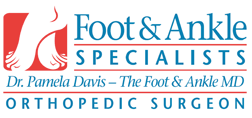Hallux Rigidus
Hallux Rigidus is arthritis of the joint at the base of the big toe. A large, painful bump forms at the base of the big toe and the joint gets very stiff. Sometimes an injury to the big toe results in arthritis, but more commonly arthritis develops without a known cause or injury. For women, at first the big toe is only painful when wearing a dress shoe with a narrow, pointed toe box and high heel. For men, at first the big toe is painful only when wearing tight dress shoes. As the toe becomes stiffer, the toe hurts even when wearing sports shoes and flats with a wide toe box. When you have pain that affects your lifestyle in spite of wearing appropriate shoes, surgery can relieve pain. The goal of surgery is pain relief, NOT to create a “prettier foot” or make it possible to wear “high-fashion” shoes.
Treatments
When roomy shoes no longer relieve pain, surgical treatment can be considered. Hallux Rigidus correction is an outpatient surgery. Usually patients go home one to two hours after surgery when they are awake, eating, drinking, and using the restroom without difficulty. Typically, pain pills are started before going home, often before pain is experienced.
Cheilectomy (Spur Removal): The bone spurs on the top of the toe are removed. This surgery takes away the pain caused by the spurs jamming together. The toe remains stiff after surgery. The arthritis also remains so the toe may still be painful during and after activity and with weather change. The benefit of this surgery is that the toe is less bulky and still moves so a greater variety of shoes may be worn after surgery. The arthritis can continue to progress, so additional surgery may be needed in the future.
Fusion: Fusion occurs when the bones on either side of the joint grow toe together to make one bone. The arthritic joint is removed and the toe becomes completely rigid. Pain relief is excellent with this surgery, but shoe wear is significantly limited. It may be difficult or impossible to get into certain boots because the toe no longer bends. Additional surgery is almost never needed after this surgery.
Joint Resurfacing (partial replacement): This surgery significantly decreases or eliminates the pain and maintains toe motion. It is possible to wear a greater variety of shoes after this surgery. There are many different types of joint replacement and many have a high failure rate. There is a new resurfacing implant called HemiCAP which has very good short term results.
After Surgery Care
Please review your after surgery care instructions and our general after surgery care page. If you experience any issues or have questions related to your surgery call us immediately!
After surgery, the foot is covered with a bulky, compressive bandage. It is common to see blood on the bandage and it may seem like a lot of blood! But it isn’t. It seems like a lot of blood because the blood spreads out as it is absorbed by the cotton gauze bandage – much like a drop of water spreads out on a paper towel. Do not worry about blood on the bandage. If the presence of blood is uncomfortable or bothers you, call the office and we will arrange a time for you to come in to have the bandage changed.
Risks of Hallux Rigidus Surgery
Occasionally complications or problems such as the following occur during or after surgery. With every surgery there are general risks. Some specific risks of this surgery are:
Malposition of the toe: This occurs infrequently with fusion due to technical issues of trying to position the toe for standing and walking while the surgery is done with the patient laying on the operating table.
Continued pain or stiffness: This does not occur with fusion, but may occur with the cheilectomy and joint resurfacing.
